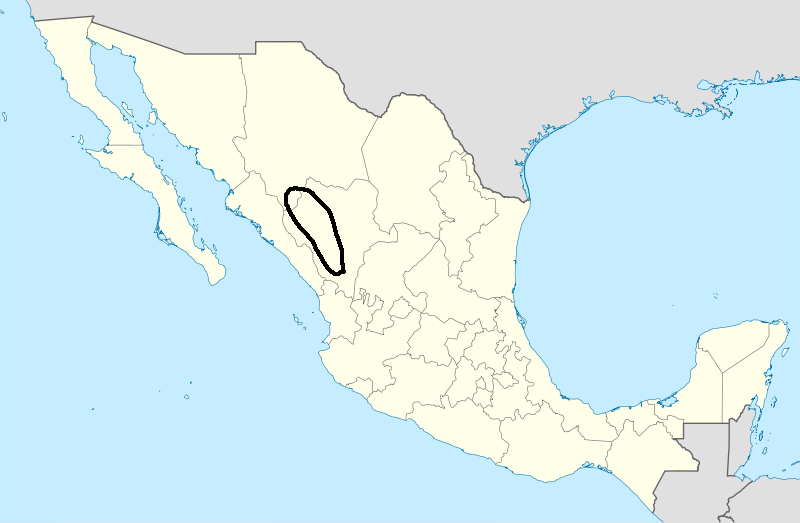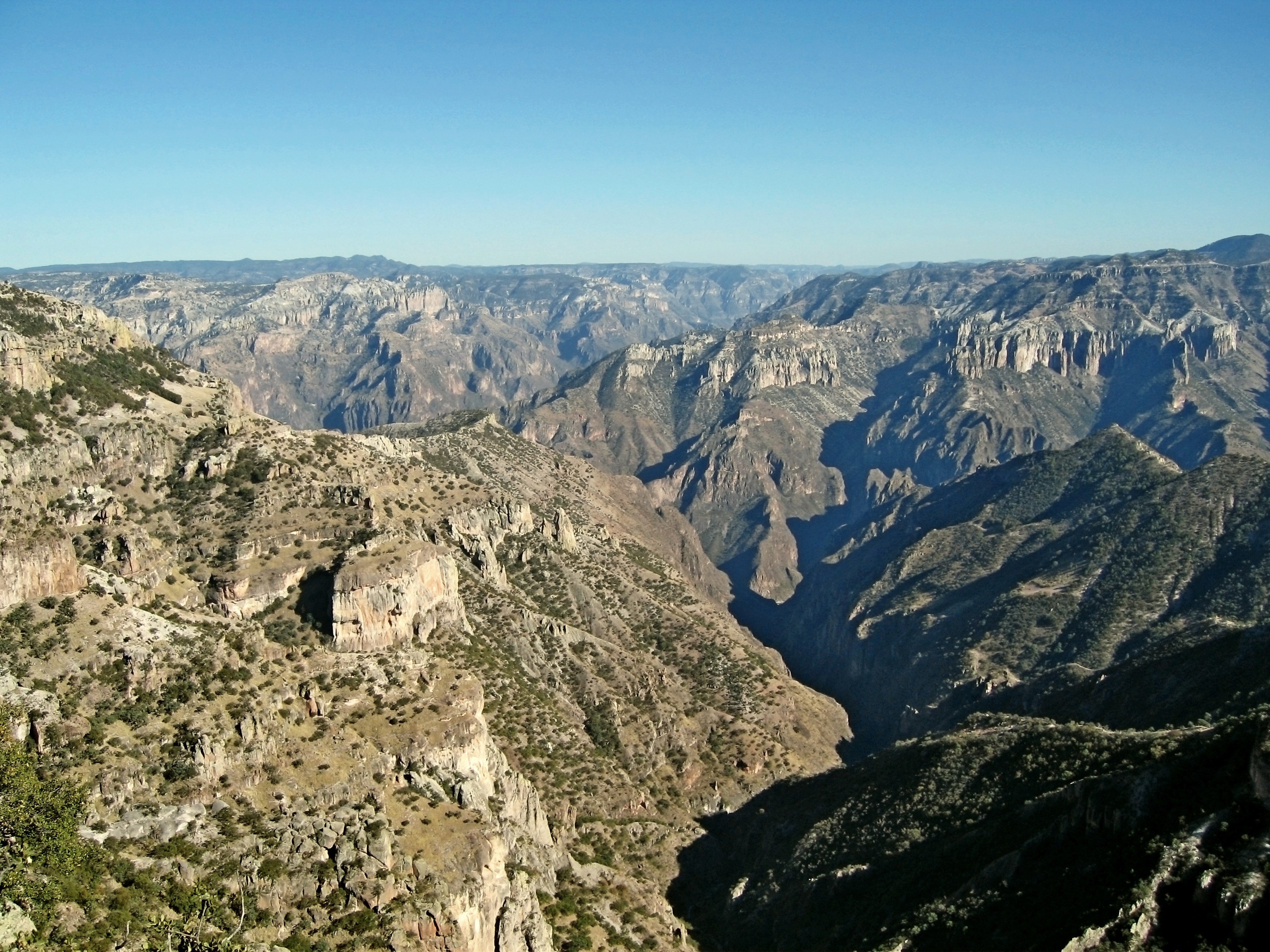|
El Zape
El Zape is a small town in the hills of the municipality of Guanaceví, in the state of Durango, in northern México. El Zape is the 3rd largest town in Guanaceví. El Zape postal code is 35440. It is located on the eastern side of the Sierra Madre Occidental, at an altitude of 1960 m (6430 ft). History Tepehuán arrival and founding of El Zape The region of El Zape was first settled by Thepehuan people. In the late 1500s the Spanish discovered silver in Guanaceví, prompting a rush to settle the region. In 1596, father Jeronimo Ramirez visited the settlement of El Zape. In 1597, he built the mission of San Ignacio de El Zape. Later, in 1604 Father Juan Fonte founded the town of El Zape. Tepehuán Revolt The conditions in which native people lived under colonial rule led them to revolt in 1616, attacking Spanish settlements in what is known as the Thepehuan Revolt. The neighboring residents of Guanaceví donated seeds, tools, and animals to El Zape. During this time th ... [...More Info...] [...Related Items...] OR: [Wikipedia] [Google] [Baidu] |
Telephone Numbers In Mexico
Telephone numbers in Mexico are regulated by the Federal Telecommunications Institute, an independent government agency of Mexico. The agency published the ''Fundamental Technical Plan for Numbering'' (''Plan Técnico Fundamental de Numeración'') on May 11, 2018. The plan establishes a uniform ten-digit telephone number format. It took effect on August 3, 2019. Telephone number format All telephone numbers in Mexico have ten digits. The size includes a one-digit area code prefix that identifies eight principal geographic region of the country. The national number was formed by prefixing the previously existing local number format with an area code. All ten digits must be dialed, even for local calls. Dialing prefixes Since August 3, 2019, only the following dialing prefixes are available for use within Mexico: Dialing into Mexico Destinations in Mexico are dialed from foreign location by dialing the foreign country's International access code (''011'' in US, ''00'' in ... [...More Info...] [...Related Items...] OR: [Wikipedia] [Google] [Baidu] |
Society Of Jesus
, image = Ihs-logo.svg , image_size = 175px , caption = ChristogramOfficial seal of the Jesuits , abbreviation = SJ , nickname = Jesuits , formation = , founders = , founding_location = , type = Order of clerics regular of pontifical right (for men) , headquarters = Generalate:Borgo S. Spirito 4, 00195 Roma-Prati, Italy , coords = , region_served = Worldwide , num_members = 14,839 members (includes 10,721 priests) as of 2020 , leader_title = Motto , leader_name = la, Ad Majorem Dei GloriamEnglish: ''For the Greater Glory of God'' , leader_title2 = Superior General , leader_name2 = Fr. Arturo Sosa, SJ , leader_title3 = Patron saints , leader_name3 = , leader_title4 = Ministry , leader_name4 = Missionary, educational, literary works , main_organ = La Civiltà Cattolic ... [...More Info...] [...Related Items...] OR: [Wikipedia] [Google] [Baidu] |
Guanaceví
Guanaceví is a town located in the northwest of the Mexican state of Durango. As of 2015, the town of Guanaceví had a population of 2,908. It serves as the municipal seat of the municipality of Guanaceví, which in the 2015 Census had a population of 9,851. It is filled with mines that contain many minerals such as gold, silver, and brass. It has many food traditions that includes sopes, enchiladas, chapaneco, tezhuino, queso, chiles rellenos, etc. Early history of this town can be found in Perez de Ribas Paginas, book3. References Andres Perez de Ribas Historia de los triunfos de Nueva Santa Fe 646 __NOTOC__ Year 646 (Roman numerals, DCXLVI) was a common year starting on Sunday (link will display the full calendar) of the Julian calendar. The denomination 646 for this year has been used since the early medieval period, when the Anno Domin ...1944 Mexico City 3vols. External links *https://web.archive.org/web/20061124110015/http://www.e-local.gob.mx/work/templates/enci ... [...More Info...] [...Related Items...] OR: [Wikipedia] [Google] [Baidu] |
Tepehuán Revolt
The Tepehuán Revolt broke out in Mexico in 1616 when the Tepehuán Indians attempted to break free from Spanish rule. The revolt was crushed by 1620 after a large loss of life on both sides. The Tepehuán people The Tepehuán people lived on the rugged eastern slopes and valleys of the Sierra Madre Occidental, primarily in the future state of Durango. They spoke a Uto-Aztecan language and depended mostly on agriculture for their livelihood. Thus, they differed from their neighbors in the deserts to the east, the Chichimeca who were nomadic and semi-nomadic hunter-gatherers. The Tepehuán, Acaxee, and Xixime to their west shared common traits such as The Tepehuán suffered a series of devastating epidemics of European-introduced diseases in the years before the revolt. Epidemics were known to have occurred in their region in 1594, 1601-1602, 1606-1607, 1610, and 1616-1617. The Tepehuán and their neighbors may have been reduced in population by more than 80 percent by the ... [...More Info...] [...Related Items...] OR: [Wikipedia] [Google] [Baidu] |
Tepehuán People
The Tepehuán are an indigenous people of Mexico. They live in Northwestern, Western, and some parts of North-Central Mexico. The indigenous Tepehuán language has three branches: Northern Tepehuan, Southeastern Tepehuan, Southwestern Tepehuan. The heart of the Tepehuan territory is in the Valley of Guadiana in Durango, but they eventually expanded into southern Chihuahua, eastern Sinaloa, and northern Jalisco, Nayarit, and Zacatecas. By the time of the Spanish conquest of the Aztec Empire, Tepehuan lands spanned a large territory along the Sierra Madre Occidental. Tepehuán groups are divided into the Ódami (Northern Tepehuán), Audam (Southwestern Tepehuán), and O'dam (Southeastern Tepehuán), each with their own language, culture, and beliefs. Name ''Tepehuán'', alternately ''Tepeguán'', derives from the Nahuatl term ''Tēpēhuanih'', meaning "Mountain Dwellers" or "Mountain People". The ''tepe'' element comes from Nahuatle ''tepetl'' (mountains), and ''huan'' com ... [...More Info...] [...Related Items...] OR: [Wikipedia] [Google] [Baidu] |
Sierra Madre Occidental
The Sierra Madre Occidental is a major mountain range system of the North American Cordillera, that runs northwest–southeast through northwestern and western Mexico, and along the Gulf of California. The Sierra Madre is part of the American Cordillera, a chain of mountain ranges (cordillera) that consists of an almost continuous sequence of mountain ranges that form the western 'sounds' of North America, Central America, South America and West Antarctica. Etymology The Spanish name ''sierra madre'' means "mother mountain range" in English, and ''occidental'' means "western", these thus being the "Western mother mountain range". To the east, from the Spanish ''oriental'' meaning "eastern" in English, the Sierra Madre Oriental range or "Eastern Mother Mountains" runs generally parallel to the Sierra Madre Occidental along eastern Mexico and the Gulf of Mexico. The range extends from northern Sonora, a state near the Mexico–U.S. border at Arizona, southeastwards to the ... [...More Info...] [...Related Items...] OR: [Wikipedia] [Google] [Baidu] |
Carretera Federal 23
Carretera (Spanish "highway") may refer to: *''La Carretera'', album by Julio Iglesias 1995 * "La Carretera" (song), 2016 song by American singer Prince Royce See also *Carretera Central (other) *Carretera Austral The Carretera Austral (CH-7, ''in English: Southern Way'') is the name given to Chile's Route 7. The highway runs south for about from Puerto Montt to Villa O'Higgins, passing through rural Patagonia. Carretera Austral provides road access t ..., Chile * Carretera de Cádiz, one of the 11 districts of the city of Málaga, Spain {{dab ... [...More Info...] [...Related Items...] OR: [Wikipedia] [Google] [Baidu] |
List Of Mexican Federal Highways
This is a list of numbered federal highways (''carreteras federales'') in Mexico. Federal Highways from north to south are assigned odd numbers; highways from west to east are assigned even numbers. The numbering scheme starts in the northwest of the country (in Tijuana, Baja California). The highest designation, Mexican Federal Highway 307, is assigned to roads hugging the coast of Quintana Roo and the international border in Chiapas. This list identifies the road starting point at the north or the west point of the highway and terminus at its eastern or southern point. Motorways and roads with restricted access are considered part of the Federal Highways network and follow the same numbering schema. The letter "D" (for Directo) is added to the road number for all toll roads. For information on toll roads, see List of Mexican autopistas. List of highways >> ... [...More Info...] [...Related Items...] OR: [Wikipedia] [Google] [Baidu] |
Area Code 674 (Mexico)
Area code 674 serves several municipalities in the western highlands in the State of Durango. The area code was created in 2002 as a result of the consolidation of location specific area codes 181, 182 and 183. The local area code went from 186 and 187 to 1, at the same time, the local number length increased from 5 to 7 digits. In the process, the area code went from designating a city or town to designating a geographical area. The 674 area code is centered in Santiago Papasquiaro. The original code for the city of Santiago Papasquiaro was 186. A total of 206,286 numbers have been assigned to this area code as of November 2018. There is one state in the area code. Cities and Towns in the area code: 23 Companies providing phone service in the area code: 28 Local Number: 7 Digits {, class="wikitable" , - ! From !! To a Landline !! To a Cell Phone (Caller paid CPP) !! To a Cell Phone (Receiver paid MPP) , - , Landline (Local dialing) , , 7 digits , , 044 + 674 + 7 d ... [...More Info...] [...Related Items...] OR: [Wikipedia] [Google] [Baidu] |
States Of Mexico
The states of Mexico are first-level administrative territorial entities of the country of Mexico, which is officially named United Mexican States. There are 32 federal entities in Mexico (31 states and the capital, Mexico City, as a separate entity that is not formally a state). States are further divided into municipalities. Mexico City is divided in boroughs, officially designated as or , similar to other state's municipalities but with different administrative powers. List ''Mexico's post agency, Correos de México, does not offer an official list of state name abbreviations, and as such, they are not included below. A list of Mexican states and several versions of their abbreviations can be found here.'' } , style="text-align: center;" , ''Coahuila de Zaragoza'' , , style="text-align: center;" colspan=2 , Saltillo , style="text-align: right;" , , style="text-align: right;" , , style="text-align: center;" , 38 , style="text-align: center;" , , , - , ... [...More Info...] [...Related Items...] OR: [Wikipedia] [Google] [Baidu] |
Postal Codes In Mexico
{{Mexico-stub ...
Postal codes in Mexico are issued by SEPOMEX (Servicio Postal Mexicano) (Mexican Postal Service). They are of five digits and modelled on the US ZIP Code system. The first two digits identify a state (or part thereof); and assignments are done alphabetically by state name, except for codes in the 0xxxx–1xxxx range which identify the '' delegaciones'' (boroughs) of Mexico City. See also * List of states of Mexico * Mexico state-abbreviation codes Mexico Mexico ( Spanish: México), officially the United Mexican States, is a country in the southern portion of North America. It is bordered to the north by the United States; to the south and west by the Pacific Ocean; to the southeast by Guate ... [...More Info...] [...Related Items...] OR: [Wikipedia] [Google] [Baidu] |



